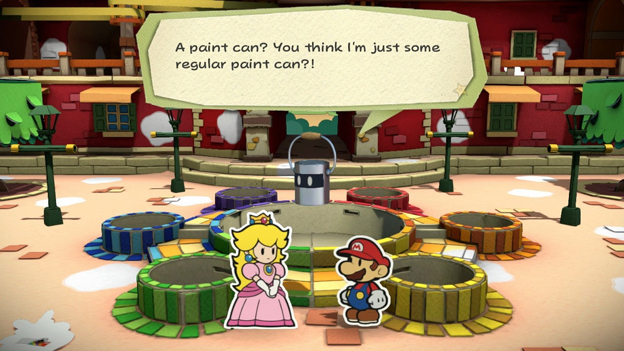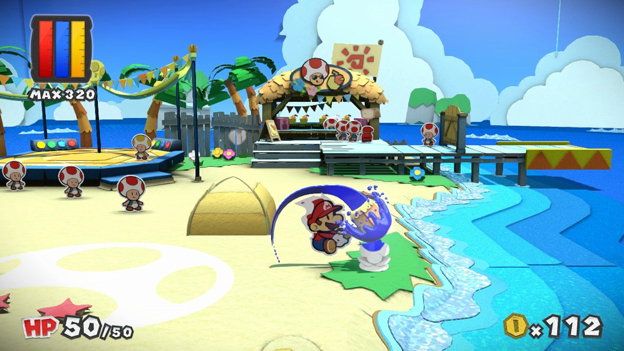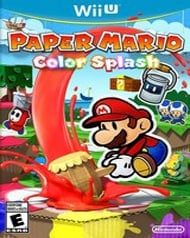Nearly Picture-Perfect, but Nintendo Spilled Some Ink
If you’d asked me last year, I would have told you that Yoshi’s Woolley World was the pinnacle of Nintendo’s craft-based game trend. Everything there looked so darn touchable that I didn’t think it could get any better. Then along came Paper Mario: Color Splash and its amazingly detailed, ever-changing papercraft world to prove me wrong. Despite well-founded worries, this title not only displays Nintendo at its audio-visual best, it’s genuinely fun to play and often quite funny, as well. Only a few design missteps keep it from climbing to the top of the heap.
This time around, Paper Mario is off to Prism Island after being mailed a freaky paper Toad that has been drained of all its color. The entire island is being drained of paint by a “mysterious” foe (I’ll give you one guess who it is), and it’s up to Mario and talking paint can Huey to set things to rights. It’s all basically an excuse for you to be able to play with paint as well as paper, with Mario able to splash color back into the world with his magical paint hammer.
When our 2D hero disembarks from his cute paper ship onto the island, we get our first look at the Paper Mario world in HD, and it’s what the series has deserved all along. Everything is made of different kinds of cardboard or paper, with textures so real they look like they should fly off the screen and onto a craft table. There are many impressive papercraft set-pieces to be found throughout, my favorites being a huge haunted mansion and a paper train straight out of any railroad fan’s fantasies. Every corner of the world has been crafted with care and creativity, and it’s a genuine delight to enter each new scene and discover what lies in store. Even the character animations are perfectly papery, as they fold and flutter about.
It’s not just looks that make this paper world so much fun. It’s the way you interact with it. The entire adventure unfolds like origami as you re-color and otherwise interact with the levels. You’ll make changes, large and small, to the areas you encounter as you play. Turn a poisoned park pristine again, fix up a battered train, or even flatten out a paper road that’s been curled into a loop by the bad guys. It’s a level of permanent change that’s unprecedented in a Mario game, and it’s not only enjoyable to watch, it feels satisfying. Finally, Mario is making a lasting difference!
The puzzles you’ll need to solve to transform these levels can be mildly tricky, but they’re rarely frustrating. There are a few pixel hunts, but usually you’ll catch on to the solutions without too much difficulty. As usual for Nintendo, there are clever hints hidden in the text and in your surroundings to help you out. You can call out Huey the paint can for a more explicit hint (often useful, occasionally frustratingly unhelpful), and you can flat out ask a Toad in the main town which objects you’ll need to take along with you to solve the next major puzzle coming your way. That last part is a sad by-product of the card system that I’ll discuss later, and the only sour spot when it comes to the game’s puzzles.
Color Splash isn’t just charming and entertaining to play, it’s downright funny at times. Early Paper Mario games have had a wordiness issue, while its direct predecessor Sticker Star hardly had any dialogue at all. This game finally nails the balance, with jokes that get right to the point and don’t overstay their welcome. Some are generally funny, while others are great Nintendo nods like, “What in the Lost Levels is going on here?”

Miniature stories found in each area you visit also make this world far more welcoming and interesting than Sticker Star ‘s, especially because you’ll visit many areas a few times in order to fully resolve all their problems and find all the paint stars you need to restore the world’s color. Fortunately, the backtracking required isn’t troublesome, as the world map helps you get around quickly.

The final thing that makes Color Splash special is its excellent soundtrack. Let’s face it, Mario music is great, but by now we’ve heard it remixed far too many times. Instead of re-re-re-hashing those tunes or attempting to copy their style, Color Splash sports a fully original soundtrack that draws from a ton of musical traditions like folk, jazz, country, and various dance styles. The songs are catchy and extremely varied. I even went to the game’s museum, where you can unlock music whenever you paint 100% of the colorless spots in a level, to listen to the tunes on their own sometimes. I never do that.
All these things point to an adventure game masterpiece, and it would be if not for a few elements that drag it down. For the “action” part of the action-adventure formula, you’ll be engaging in the typical turn-based/timed button press combat system we’ve seen in all the Mario & Luigi and Paper Mario games. This one is a fairly stripped down version of the format, with a limited number of enemies on screen and only one simple block move that can help you take half damage from your foes.
The main gimmick is that all of Paper Mario’s attacks come in the form of consumable cards that you can paint before throwing out in order to do more damage. At the start, you can play one card per turn, but you’ll get more per turn later on in the game. Your paint supply is a limited resource, which I believe is meant to inspire strategic decisions in battle. In reality, though, paint is super easy to collect in the levels and can even be recharged in the middle of battle with a 1-up card. So instead the paint mechanic becomes just one extra step you need to take every single turn of battle. Card collection itself can be fun, as it helps you change up your attacks, but the attendant inventory management can be a pain. If you happen to be running low on cards at the end of a level, that means interrupting the flow of play to head back to the main town and buy more cards. It’s not a game-killer, but it’s a nuisance.

The main issue with the card battle system is that it only hits its sweet spot for a while in the middle of the game. At the beginning, when fights are dead easy, it’s just dull. In the mid-game, battles become more like puzzles, daring you to select the correct cards and successfully pull off their attacks in order to end fights as quickly as possible (monsters start doing some pretty major damage mid-game). That’s fun for a bit, but later in the game I increasingly found it a chore to flick through my extensive deck, pull out individual cards, hold down my stylus color them, and THEN flick them off the touch screen every single turn – and that’s the process with the fast battle option turned on. Several simple changes could have alleviated this, like shortcut buttons to help you navigate your deck faster or unlimited-use cards for basic attacks, but we’re simply not given those labor saving choices.
The consumable card system also hinders the fun of puzzle solving. A major problem that people complained about in Paper Mario: Sticker Star was the “thing” stickers, objects used to solve puzzles in levels and boss battles. You never knew which “things” you’d need ahead of time and the stickers were consumable, so if you didn’t have the right ones, you’d have to exit a level or lose a boss fight, then backtrack to town to get different ones. Color Splash uses consumable “thing” cards and solves the backtracking problem with an NPC who straight-up tells you which “things” to put in your inventory for the puzzles ahead. He’s optional, but there’s really no other way to pack the right “things” ahead of time (taking all of them would use up around a third of your deck space and isn’t really viable). It’s unfortunate, because there are clever hints about which thing to use baked into the levels and boss fights already. If only the “things” weren’t consumable, these puzzles could have stood on their own. Fortunately, “thing” cards are only used in a small number of puzzles, so you’ll have plenty of other chances to solve things on your own.
Beyond the issues with the card system, the worst design choice in Color Splash is the lack of character diversity. Nearly every character in the game is a Toad. Sure, some have slightly different personalities and some wear funny hats, but in the end, they’re all Toads – silly and rather incompetent. It’s monotonous and such a drastic contrast to the tremendous creativity seen in the level design that it feels like it was imposed from outside. Heck, we don’t even get to see new enemies or bosses anywhere in the game. They’re all brought over from previous Mario platforming titles. Is no-one but Shigeru Miyamoto allowed to add new characters or monsters to the Super Mario universe these days? I sure hope that’s not the case, because that over-familiarity is a black mark against an otherwise wonderfully novel world.
Paper Mario: Color Splash has a lot going for it. Most of the time, it’s the kind of game that simply brings a smile to your face as you enjoy the fresh world and amusing dialogue. If it weren’t for the tedious side effects of the card system and the disappointingly unoriginal cast, it could be a genuine Game of the Year award contender. As it is, it’s still thoroughly worthwhile for its enchanting paper world (and the attendant tunes) alone. This game is about 80% whimsy, wonder, and silly grins – which makes it worth your while to put up with the few ways that it doesn’t shine.
RATING OUT OF 5 RATING DESCRIPTION 5.0 Graphics
Perfect papery textures, flawless animation, and endless creativity make this among the best game worlds to explore in 2016. 3.5 Control
The “adventure” segment of the game works very well, but the card battle system is too drawn-out and lacks needed shortcuts to make battle flow efficiently. 4.8 Music / Sound FX / Voice Acting
Abandoning the staple Mario tracks for an original collection of folk and dance tunes was a fantastic idea. 3.5 Play Value
Surprisingly extensive for a Mario series game, and easy to navigate, to boot. Card battle tedium limits its long-term appeal, however. 4.0 Overall Rating – Great
Not an average. See Rating legend below for a final score breakdown.
| Review Rating Legend | |||
|---|---|---|---|
| 0.1 – 1.9 = Avoid | 2.5 – 2.9 = Average | 3.5 – 3.9 = Good | 4.5 – 4.9 = Must Buy |
| 2.0 – 2.4 = Poor | 3.0 – 3.4 = Fair | 4.0 – 4.4 = Great | 5.0 = The Best |
Game Features:
